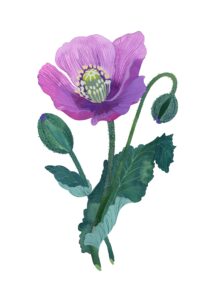 Poppies in July, Poppies in October
Poppies in July, Poppies in October
By Jade Lee (’24)
Among the most well-known and important of Sylvia Plath’s work are two poems about Papaver rhoeas, otherwise referred to as the common poppy. “Poppies in July” and “Poppies in October” both examine the human condition, while also scrutinizing the symbolic potential of this plant. Plath had significant encounters with poppies while living in England, where they have cultural significance specifically in relation to World Wars I and II as symbols of remembrance and the price of war, and more broadly symbols of fertility, joyful motherhood, and addiction (see Lack 2016: 14). However, Plath appears to play with these associations in her poetry. Looking closely at her poems and their biographical context, we can see that her poem written in July depicts the bitterness of motherhood, which both aligned with and contrasted the attitudes she had toward the subject. The poem written in October then reevaluates the complexity of failed marriages, miscarriages, and endings where there once were beginnings, almost as though she was reevaluating her own life as she witnessed the poppies’ inevitable decline. Plath exploited symbolic contradiction within these poems, which reflected many of the events that were happening in her life at the time.
In 1962, Plath was trying to divorce her husband Ted Hughes while writing to her friends that she was “fine.” She struggled to find a live-in au pair up until the week of her death while contemplating ending her life (see Clark 2020: 854-95). If we peer further back to the beginnings of her career, it is clear that she resented the idea of becoming a woman ensnared by marriage and children in the first place; being relegated to child-bearer and homemaker. By the time she was in England, this fear became true. In a December 1961 letter to Stern, she writes (Plath 2018b: 693-4):
What I miss most is (I don’t quite know how to put it) “college-educated” mothers. I got to know several nice, bright girls in London whom I miss, but there’s nobody like that round here…but it’s all baby talk. I find myself liking baby talk, but I miss the other things—notions, ideas, I don’t know what.
Plath’s life and work are often reduced to the most simplistic of terms. It is a shame that most pigeonhole her when Plath contains multitudes—so many interesting contradictions and so much nuance. She knew no boundaries, consistently trying to convince the world that she was an artist that someone would want to take a second look at. In the months leading up to her death, she was planning the long work of her second novel “Double Take” (later given the title, “Double Exposure”), while simultaneously writing nearly a poem a day, almost as though she were running out of time. Plath should be known for her boundlessness and her countervailing interests and desires, rather than just her infamous depression and untimely end.
With this careful observance, consciousness, and theorizing one’s own condition, Sylvia Plath took many notes of the British poppy in the context of the season of life she was enduring. What resulted was some of the most important confessionalist work of the 20th century. One can only hope that it lent some reprieve from the pain that she revealed only for her pennable legacy, of which her immeasurable multitudes continue to emerge.
Works Cited
Clark, Heather L. 2020. Red Comet: The Short Life and Blazing Art of Sylvia Plath. New York, NY: Vintage.
Lack, Andrew. 2016. Poppy. Reaktion Books.
Plath, Sylvia. 2018a. The Collected Poems. Reprint edition. New York: Harper Perennial Modern Classics.